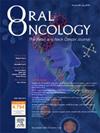Long read sequencing identifies complex structural variant landscape and recurrent TERT rearrangements in mucoepidermoid carcinoma
IF 4
2区 医学
Q1 DENTISTRY, ORAL SURGERY & MEDICINE
引用次数: 0
Abstract
Mucoepidermoid Carcinoma (MEC) is a common salivary malignant neoplasm. Approximately 60 % of MECs harbor translocations between CRTC1 or CRTC3 and MAML2, which are thought to drive disease pathogenesis. However, the precise structural mechanism driving this rearrangement remains uncharacterized. Here, we performed multi-omic and long read genomic sequencing, discovering a chain of alterations that created the CRTC1::MAML2 fusion, but also an unexpected MAML2 to MYBL1 rearrangement, suggesting that MYBL1 may play a larger role in salivary gland cancers than previously recognized. Furthermore, we discovered and validated recurrent TERT rearrangements and amplifications in MEC models. 5/5 MEC cell lines and 36/39 (92 %) primary MEC tumors harbored a TERT rearrangement or copy number amplification. Custom sequencing of the TERT locus confirmed translocation breakpoints in 13/33 (39 %) MECs, while exome sequencing confirmed frequent TERT amplifications. Critically, TERT knockdown in NCI-H292, a cell line with TERT promoter rearrangement, reduced clonogenic cell survival, supporting a critical role of this gene in MEC tumorigenesis. Overall, our data suggest that complex chromothripsis rearrangement mechanisms drive the formation of structural variation in CRTC1::MAML2 fusion positive and negative tumors and reveal highly recurrent structural variation driving TERT rearrangement in MEC.
长读测序发现粘液表皮样癌中存在复杂的结构变异和复发性TERT重排。
蕈样表皮样癌(MEC)是一种常见的唾液腺恶性肿瘤。大约 60% 的蕈样表皮样癌携带 CRTC1 或 CRTC3 与 MAML2 之间的易位,这被认为是疾病发病机制的驱动因素。然而,驱动这种重排的确切结构机制仍未定性。在这里,我们进行了多组学和长读基因组测序,发现了一连串的改变,这些改变造成了CRTC1::MAML2融合,同时还发现了意想不到的MAML2到MYBL1重排,这表明MYBL1在唾液腺癌症中的作用可能比以前认识到的更大。此外,我们还在MEC模型中发现并验证了复发性TERT重排和扩增。5/5的MEC细胞系和36/39(92%)的原发性MEC肿瘤都存在TERT重排或拷贝数扩增。TERT基因座的定制测序证实了13/33(39%)的MEC存在易位断点,而外显子组测序则证实了频繁的TERT扩增。重要的是,在TERT启动子重排的细胞系NCI-H292中敲除TERT会降低克隆细胞的存活率,从而证明该基因在MEC肿瘤发生中起着关键作用。总之,我们的数据表明,复杂的染色质重排机制驱动了 CRTC1::MAML2 融合阳性和阴性肿瘤中结构变异的形成,并揭示了驱动 MEC 中 TERT 重排的高度重复性结构变异。
本文章由计算机程序翻译,如有差异,请以英文原文为准。
求助全文
约1分钟内获得全文
求助全文
来源期刊

Oral oncology
医学-牙科与口腔外科
CiteScore
8.70
自引率
10.40%
发文量
505
审稿时长
20 days
期刊介绍:
Oral Oncology is an international interdisciplinary journal which publishes high quality original research, clinical trials and review articles, editorials, and commentaries relating to the etiopathogenesis, epidemiology, prevention, clinical features, diagnosis, treatment and management of patients with neoplasms in the head and neck.
Oral Oncology is of interest to head and neck surgeons, radiation and medical oncologists, maxillo-facial surgeons, oto-rhino-laryngologists, plastic surgeons, pathologists, scientists, oral medical specialists, special care dentists, dental care professionals, general dental practitioners, public health physicians, palliative care physicians, nurses, radiologists, radiographers, dieticians, occupational therapists, speech and language therapists, nutritionists, clinical and health psychologists and counselors, professionals in end of life care, as well as others interested in these fields.
 求助内容:
求助内容: 应助结果提醒方式:
应助结果提醒方式:


